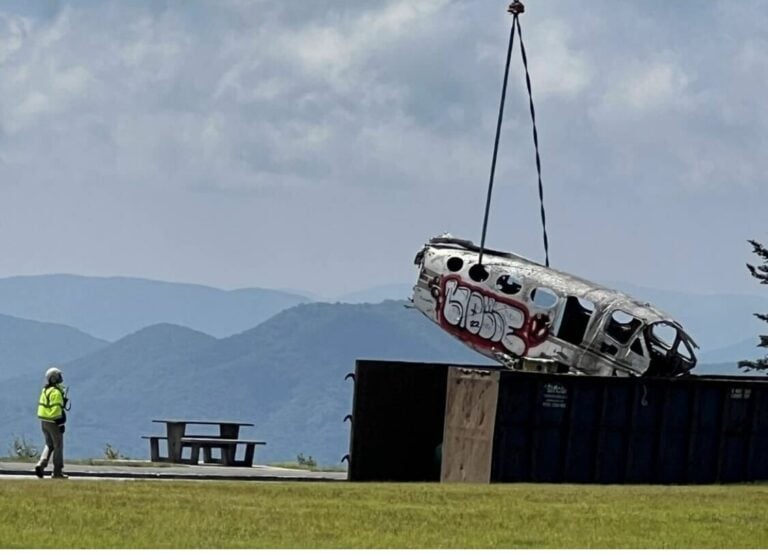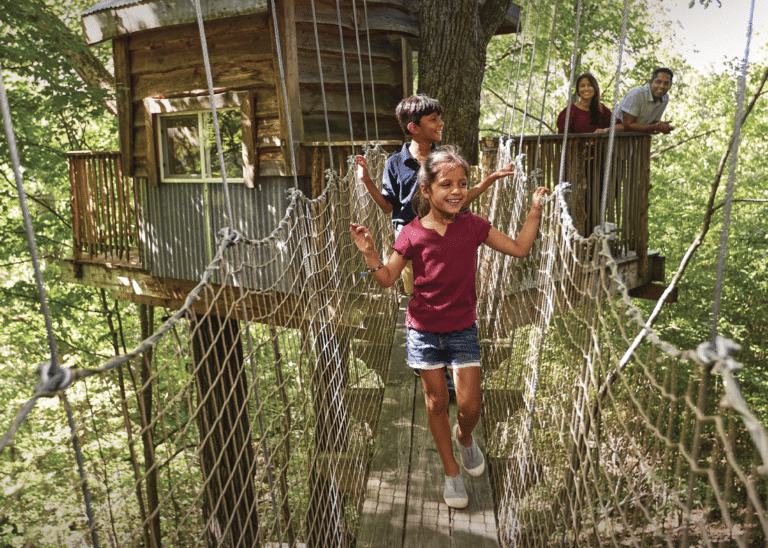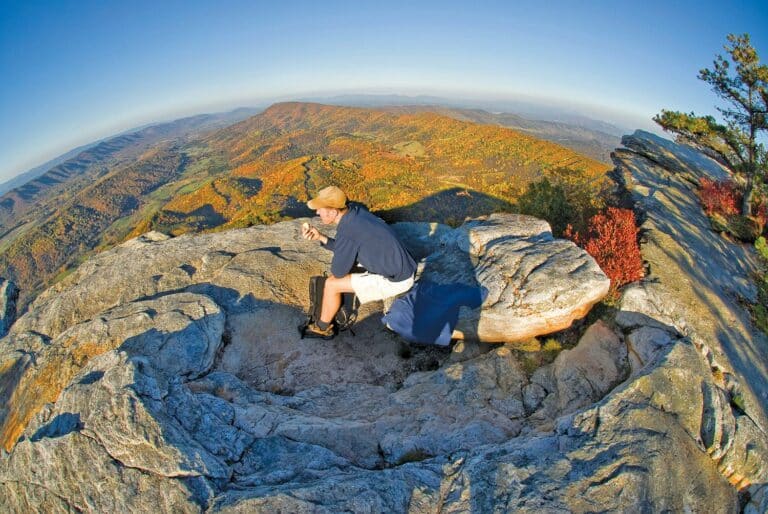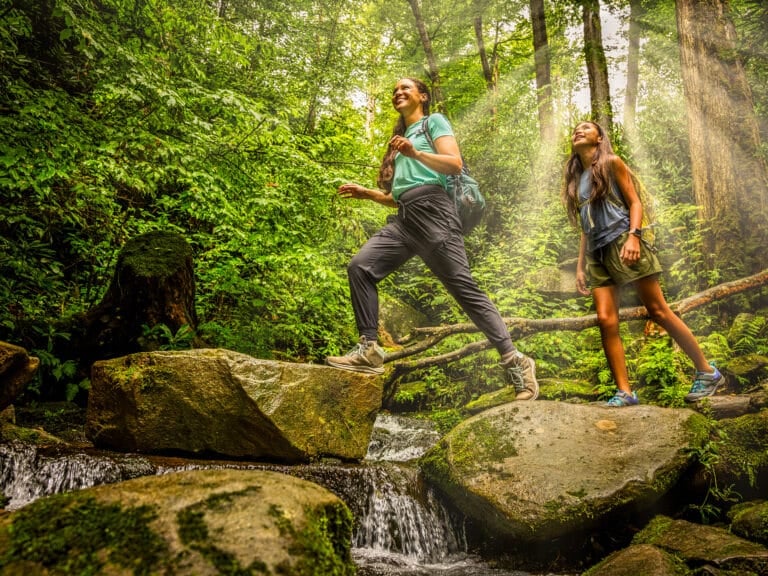The Southeast is whitewater country. Here are the best rapids for every level of whitewater, from easy class I floats to class V hairboating adventures.
Class I
The James River, Va.
Eagle Rock to Horseshoe Bend
For 343 miles, the James River sweeps across the state of Virginia, connecting the Allegheny Mountains with the Chesapeake Bay. It is a massive watershed, a vital source of drinking water, a habitat for key aquatic species, and an important source of recreation. The most well-known section of the James may be the park and play whitewater paradise through downtown Richmond, but in the mountains of Western Virginia, near the headwaters, the James is a remote, pristine paddling experience highlighted by unrivaled scenery and calm class I waters.
The run starts at Eagle Rock, just south of where the Jackson and Cowpasture Rivers converge to form the James, and extends for 13.5 miles through undeveloped farmland and private forested slopes. The mountains of George Washington National Forest are a constant backdrop and occasionally, sheer rock cliffs and steep mountain slopes rise directly from the river’s edges. It is the most remote section of the James, with no road access and very little signs of development along its entire length, and it’s the only section of the James to be classified as a “Virginia Scenic River.” A swift current and 25 class I rapids move you through water so clear you can see freshwater clams and crawfish on the rocky bottom.
“After you launch, you won’t see any signs of civilization for miles,” says Dan Mays, owner of Twin River Outfitters. “You probably won’t see any other boaters. It’s such a remote section of the river, most people choose to paddle further downstream.”
The topography is so dramatic and the paddling so unique, that the county of Botetourt is in the final stages of developing the run into the Upper James Blue Way. Also, keep an eye out for stone locks at the put in at Eagle Rock, which are remnants of dams built before the Civil War. The dams were going to serve George Washington’s massive canal system, but the railroad was developed making the canals obsolete.
Major Rapids: None. Other than a couple gentle class II’s, the only rapids you’ll encounter are the class I ripples that define this section of river.
Beware: You’re floating through private land the entire length of the trip, so there’s no camping. You’ll have to paddle the full 13 miles in a single day. Plan for about six hours.
The Guide: Twin River Outfitters in Buchannan will guide you on day trips or rent you a boat and let you loose on your own. canoevirginia.com.
More Classic Class I Rivers…
South Fork of the Shenandoah, Va.
The wide, calm South Fork carves sinuous “S” turns through the farmland of the Shenandoah Valley. In the distance, Shenandoah National Park stands to the east and the George Washington National Forest rises to the west. Numerous public access points and private campgrounds allow you to paddle for as long as you like.
South Fork of the New River, N.C.
America’s oldest river is a bit schizophrenic. In West Virginia, it’s a ribbon of class IV whitewater through a rocky gorge. But in North Carolina, it’s a wide, shallow, and placid river winding through undeveloped farmland, granite bluffs, and rolling mountains. A 26.5-mile section of the New is designated as a National Wild and Scenic River, and a state park has been established along its length. The state park offers canoe access and primitive camping facilities, making it an ideal two-day stretch.
Etowah River, Ga.
A pristine nine-mile stretch of the Etowah flows through the primitive Dawson Forest Wildlife Management Area, offering canoeists a short trip through a series of easy class I channels, drops, and shoals. Start at the new canoe launch at Etowah River Park off Highway 9 and paddle to Kelly Bridge Takeout ($3 takeout fee) for a superb introduction to whitewater.
Class II
Nantahala River, N.C.
Think of the Nantahala River in Western North Carolina as the “gateway” river. Thanks to the mild but thrilling rapids and variety of guide companies servicing the river, this class II run through the narrow Nantahala Gorge is often the first taste of whitewater for budding paddlers. It’s a perennial favorite for families looking for some adventure as well as new kayakers looking to hone their skills.
“The whitewater isn’t very difficult, but it has a lot of variety,” says Andrew Holcombe, a professional kayaker who grew up on the Nantahala. “You can learn the basic roll in a lake, then move to the Nantahala to start developing all the other skills you need to kayak. It’s ideal.”
The consistency of the whitewater also makes the Nantahala ideal for beginners. Almost every day of the year, thousands of gallons of water are released from Nantahala Lake, turning an 8.5-mile stretch of the Nantahala into an almost continuous class II whitewater run. The river is flanked by steep mountains stretching toward the sky as it winds through a narrow gorge inside the Nantahala National Forest. Easy access has turned the Nanty into a popular park and play river, so watch for experienced kayakers surfing the many wave trains and running laps on some of the more aggressive rapids that punctuate the run. The Nantahala’s accessibility, consistent river releases, and dependable but challenging whitewater has also turned it into a training ground for Olympic whitewater boaters. It’s the home river for the Nantahala Racing Club, arguably the premiere whitewater team in the country, and the site of nationally recognized competitions like the Glacier Breaker and the Bank of America Whitewater U.S. Open.
Major Rapids: The barrage of class II water is bookended by two class III’s. Patton’s Run is a ledge leading into a series of waves that gives new rafters trouble just after the put in, and Nantahala Falls caps the run. The falls is a technical rapid that demands an “S” move as you navigate through fast wave trains and a decent drop through a narrow channel sandwiched by two massive boulders. Dozens of onlookers often loiter near the rapid hoping to see carnage.
Beware: The Nantahala is one of the most popular whitewater rivers in the country, so expect crowds on summer weekends.
The Guide: The Nantahala Outdoor Center has been guiding the Nantahala for 30 years. They’re also one of the premiere paddling schools in the country, taking newbie kayakers through the progression of flatwater to mastering Nantahala Falls. noc.com.
More Classic Class II Rivers…
Abrams Creek, Tenn.
The nine-mile stretch known as lower Abrams Creek is packed with 20 class II rapids including some long wave trains and surprisingly sprite play spots. The river sits on the northwestern corner of the Great Smoky Mountains National Park, so it’s as remote of a run as you’ll find in these parts. Combine it with the 10-mile upper Abrams, which has more class II-III water (portage around class V Abrams Falls) and you’ve got a two-day paddle with an overnight at Abrams Creek Campground.
Lower Green, N.C.
The Green may be known for its class V creeking (see Steep Creeks) but after the infamous Narrows, the Green mellows into a picturesque class II river. The six-mile stretch between Fishtop and Big Rock access areas is jam-packed with straightforward rapids, most of which are followed by slow pools–the ideal paddle and rest scenario for beginners.
Middle Cartecay, Ga.
This short but sweet 2.1 mile whitewater river used to be in the middle of nowhere. Today, it carves through prime vacation home real estate. Regardless, the Cartecay progresses naturally from flat water to consistent class II rapids, and ends with Blackberry Falls, a fun II+ slide that looks ferocious, but is fairly tame.
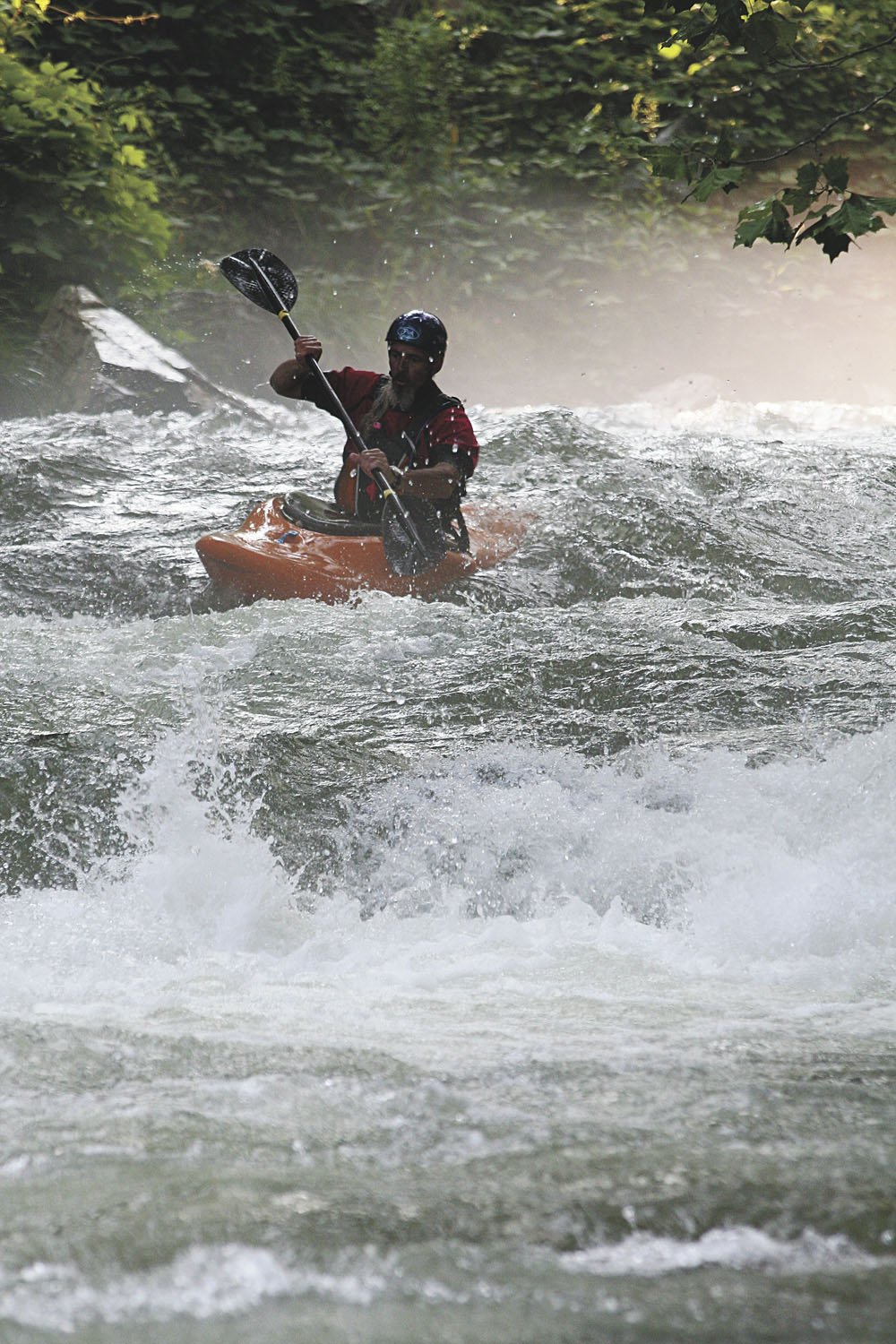
Class III
Ocoee River, Tenn.
See all those paddlers in funny looking boats doing flips and 360s in standing waves? They have the Ocoee to thank for their favorite pastime. Widely recognized as the birthplace of freestyle kayaking, the Ocoee River’s surfable waves spawned an entire niche of kayaking, characterized by high flying acrobatics and silky smooth moves on the water’s surface. For decades, playboaters have flocked to Ocoee’s playspots–rapids like Hell Hole and Flipper–during which time the river has hosted countless world class freestyle competitions.
“Lots of small drops and ledges create hundreds of hydraulics, or holes, ideal for playboats,” says Joe Jacobi, the whitewater slalom Olympic gold medalist who teaches kayaking on the Ocoee. Not that the Ocoee is all hucks and cartwheels. River runners and raft rats love the Ocoee for its continuous class III whitewater, particularly the Middle Ocoee, which drops 260 feet in five miles and features 20 named rapids.
“Fun surf waves and holes with large eddies make the river attractive for playboaters, but for paddlers in search of an interesting downriver run, there are literally scores of different lines and moves you can take through any given rapid,” Jacobi says.
The Upper Ocoee is famous in its own right for hosting the whitewater slalom competitions during the ’96 Summer Olympics. The whitewater inside the Upper section is more tame than the Middle, but combining the two makes for a seamless full day river adventure. And you’ll be able to tell your friends you ran the Olympic whitewater course.
The warm-water Ocoee runs through a rocky gorge inside the Cherokee National Forest. Steep, green mountain slopes rise from either side of the river, and a road follows the run, offering easy access for play boaters.
Major Rapids: On the Middle Ocoee, Grumpy hits boaters just after they put in below the dam. It’s a long class IV with pushy waves, the occasionally eddy, a rock famous for pinning rafts, and a killer drop. Hell Hole is probably the most famous rapid on the river. Home to a number of freestyle competitions, including the World Rodeo Championships, Hell Hole is a massive wave that playboaters wait in line to surf. On the Upper Ocoee, Humungous is the largest rapid. It’s a long, massive wave train that was the highlight of the ’96 Olympic course.
Beware: Watch out for “the doldrums,” a pocket of slow flatwater sandwiched between the Middle Ocoee’s otherwise constant whitewater.
The Guide: A variety of guide services run the Upper and Middle Ocoee. Check out the Ocoee Adventure Center (ocoeeadventurecenter.com) or the Nantahala Outdoor Center (noc.com)
More Classic Class III Rivers…
Nolichucky River, Tenn.
The eight-mile stretch of the Nolichucky leading into Erwin, Tenn. is rife with sporty class III playspots and the occasional III+-IV challenge (warning: Quartermile is a series of long drops that add up to a beastly class IV). Spend an hour surfing the wave at Jaws and boogie your way downriver through a deep, scenic gorge in Eastern Tennessee.
Davidson River, N.C.
The run actually starts with a class IV drop, but the rest of this 1.25-mile stretch of the Davidson is packed with class II and III goodies. There’s also a trail running alongside the river for easy bike or hike shuttles. The fun rapids and easy access make it an ideal “run and repeat” scenario.
Big Pigeon, N.C.
This 4.5-mile run has about a dozen class II-III+ drops, and it runs through a scenic gorge bordered by the Great Smoky Mountains National Park and the Cherokee National Forest. The Big Pigeon is revered by intermediate playboaters and river runners alike for its scenery and fun but challenging rapids like Powerhouse and Lost Guide.
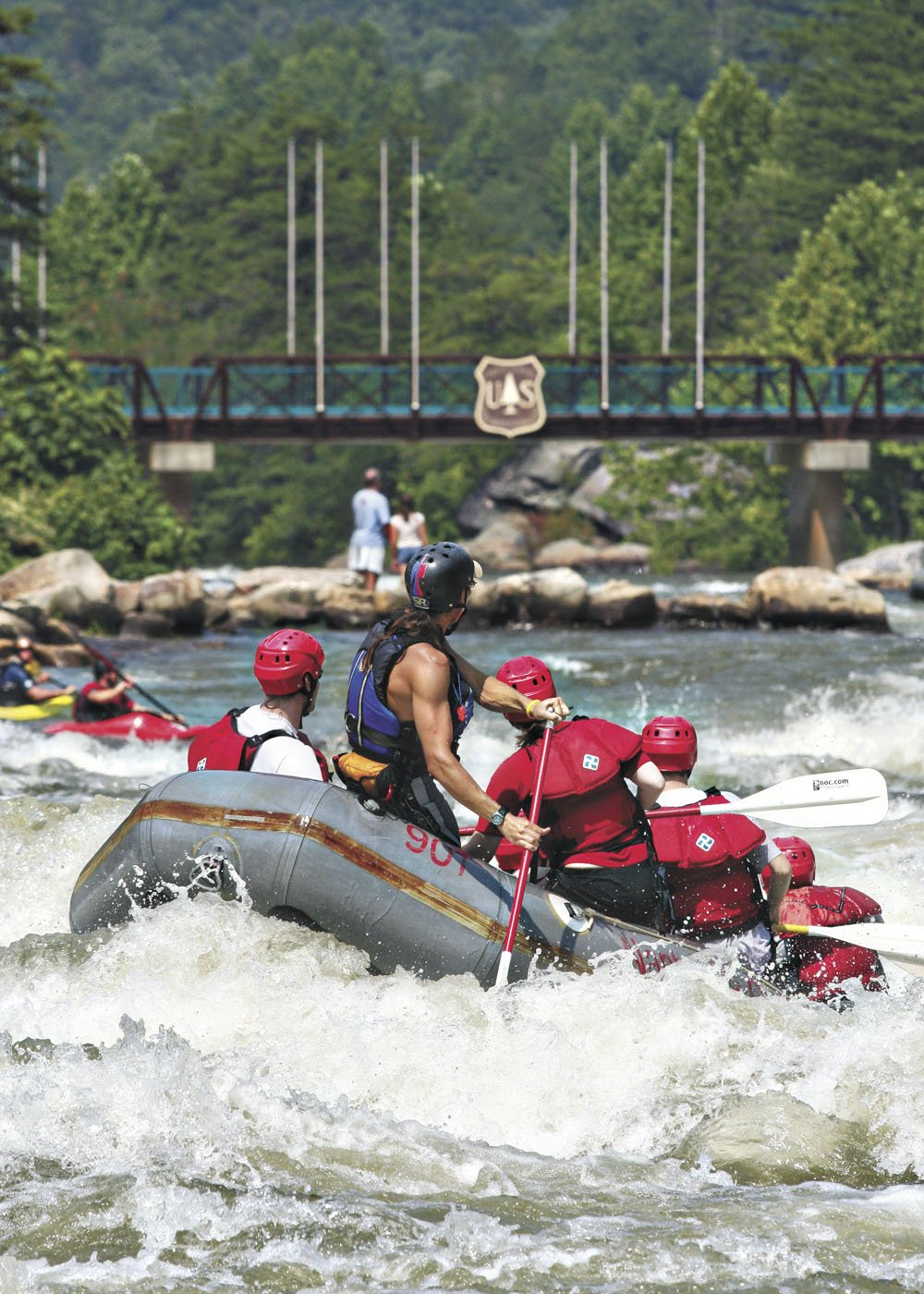
Class IV
Cheoah River, N.C.
Drive by the Cheoah on a day when there are no dam releases and the riverbed is dry, and you might not even notice that it’s there. But happen by this Western North Carolina gem when the water is turned on and rafters and kayakers are in the midst of their white knuckle descents, and you can’t help but stop and take notice. Compare all the rivers that cascade through the South, and the Cheoah stands out in a category all its own.
“I rounded up the best raft guides to run the first test run,” says Bob Hathcock, a raft guide and kayak instructor who is largely responsible for turning the water back on in the Cheoah. “Guys that lead trips down rivers in Costa Rica, Europe, Africa, Nepal. After one run, they all had the same response: ‘holy s#!%.’”
For the better part of the last 50 years, the Cheoah between Santeetlah Dam and Calderwood Lake has been left dry, but thanks to an unprecedented effort between commercial interests and private boaters, a number of annual recreational releases were secured in 2005, putting 1000 cubic feet per second of water back into this forgotten river. For 15 days out of the year, the Cheoah becomes a “western style” river with almost continuous class IV whitewater.
“In the Southeast, you have drop and pool rivers–a big rapid followed by a calm pool allowing you to rest,” Hathcock says. “But on the Cheoah, everything moves forward. You’ve got big splashy waves coming over the raft, drops sandwiched together back to back, and at one point, a mile of class IV rapids one right after the other. This is a big water river. There’s no place to stop, and there’s nothing else like that around here.”
Major Rapids: The nine-mile section between the dam and Calderwood Lake has dozens of rapids, and the water is so fast, commercial guide companies usually run this stretch in about 2.5 hours. Wilma’s Ledge (IV) is a river-wide drop that plunges six feet, offering a variety of fun lines. The Land of Holes (IV) is a mile of continuous whitewater with almost no eddies. And the Falls (IV+) is another river-wide drop, but this measures 12 feet and features a fun slide on the river right side, or a vertical drop on river left.
Beware: There really are very few places to rest on the Cheoah. Eddies are scarce, so you better know what you’re doing before you put in.
The Guide: Not only does the NOC run trips on the Cheoah, its guides (Bob Hathcock included) were pivotal in securing the dam releases that boaters enjoy today. noc.com.
More Classic Class IV…
Cheat River, W.Va.
This 9.5 miles through the Cheat Canyon is completely inaccessible, so bring your A-game. The Cheat used to be the quintessential whitewater rafting run. The New and Gauley have stolen some of the Cheat’s thunder, but the technical rapids inside the canyon are just as much fun as they were 30 years ago. Big waves, sticky holes, massive boulders, drops. Watch out for the formidable Coliseum, a class IV+ series of drops that seem to change shape with every heavy rain.
Watauga River, N.C.
A classic North Carolina creek that at one time was the benchmark run for boaters, the Watauga is a complex, technical river that winds through a steep and rocky gorge. The run is characterized by its boulder gardens and ledge drops, all of which require top notch boating skills. Keep an eye out for Hydro, a class V series of ledges that demand perfect lines, and Watauga Falls, a narrow 16-foot drop sandwiched between massive boulders.
New River, W.Va.
A prime 6.5-mile section of the New running through the heart of the gorge contains a high concentration of class III-IV rapids. Rafters love the “big water” character of the river; kayakers love the endless play opportunities presented by consistent, massive waves and holes.
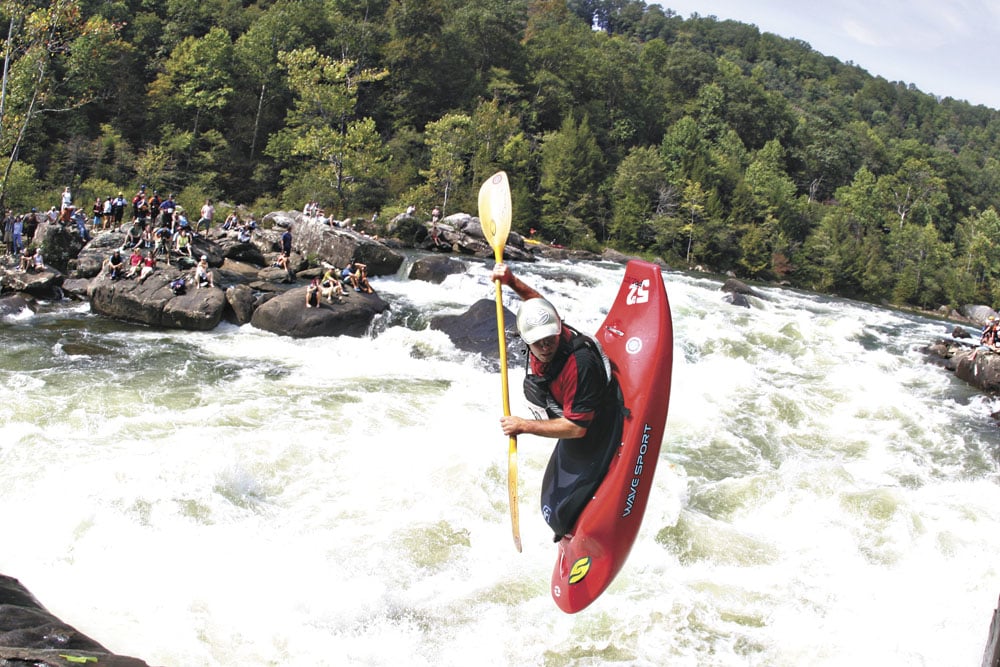
Class V
Gauley River, W.Va.
What sets the Gauley River apart from other class V rivers? Volume, pure and simple. During the fall release season, one million gallons of water are released from Summersville Dam, turning 26 miles of the Gauley River into the epicenter of big water paddling on the East Coast. The Gauley drops 650 feet over the three stretches of river known as the Upper, Middle, and Lower. During that span there are 100 named rapids, 56 of them are class III or above. Paddle the world-renowned Upper Gauley, and you’ll run 10 miles of almost constant class IV-V whitewater through a remote canyon.
“It’s impossible to be bored running the Upper,” says Brian Jennings, a pro kayaker with Riot Kayaks who grew up paddling the Gauley. “The downriver freestyle is phenomenal. Some rivers have good park and play waves, but the Gauley is constant freestyle potential. There’s always something to keep you entertained.”
The quality, quantity, and variety of whitewater on the Upper Gauley makes it the premiere class V run in the Southeast. The river can be run year-round—at lower levels during the summer, it’s more of a class III-IV creeking experience—but boaters anticipate the fall releases, known as Gauley Season, months in advance.
For the wildest ride, paddle the 10-mile Upper section. For a milder, class IV version of the river, head to the 11-mile Lower Gauley. For two days of whitewater bliss, paddle all 26 miles of the Gauley, stopping to camp along the river at night.
Major Rapids: The Upper Gauley has the most dramatic rapids on the river, known as “The Big Five.” Insignificant (V) is a long series of ledges, large waves, and sticky holes. At Pillow Rock (IV+), the entire river gets pushed into a massive boulder, creating a huge pillow that acts like a siren to boaters. Lost Paddle (V) is a ridiculously long series of drops–the longest rapid on the Upper. Iron Ring (IV+) is a double drop where the river narrows to half its size. And Sweet’s Falls (IV), the last and easiest of the Big Five, is a wave train leading into a fun drop.
Beware: The Gauley demands paddlers be on their game. You’re in a remote canyon with limited access, running both technical and big water rapids.
The Guide: The Gauley helps support an entire raft guide industry in West Virginia. Check out the North American River Runners for guided trips and kayak lessons from pros. narr.com.
More Classic Class V…
Green River Narrows, N.C.
Arguably the most famous creek run in the country, the Green River drops suddenly and drastically as it passes through a skinny, rocky canyon inside the Green River Gamelands. The Green is one of the few class V rivers with creek-boating characteristics that benefits from regular dam releases. As a result, this remote run has become a training ground for some of the best boaters in the country. Within the three-mile Narrows section, the Green is packed with almost continuous class IV-V+ boulder gardens, ledges, and drops.
Tallulah River, Ga.
Boaters worked for years to secure recreational releases from the Tallulah Falls Dam, which pumps water into the short, but sweet stretch of the Tallulah that runs through Tallulah Gorge State Park. The gorge run is 2.5 miles with seven class IV+ to V+ rapids as well as a host of water in the class IV range. Access is difficult because of the steep stone gorge walls, and there’s a lake paddle at the end of the run, but behemoth rapids like Oceana and Bridal Veil are worth the effort.
Upper Youghiogheny, Md.
For about ten miles, the Yough drops roughly 115 feet per mile, creating 20 major rapids (14 class IV, 6 class V) in a series of nonstop boulder drops, slides, rock gardens, and vertical falls. As a bonus, the run is designated Wild and Scenic by the state of Maryland, meaning you won’t see a house or power line along the entire stretch of the river. •
Classic Creeks
Russell Fork, Va.: This sub-four-mile run is on every creek-boater’s to-do list. The pool and drop creek runs through a 1,600 foot tall gorge and is known for its pushy, technical rapids that leave no room for error. Boaters converge on the river every year for the Lord of the Fork Challenge, one of the preeminent creek boating races in the country.
Wilson Creek, N.C.: The Wilson Creek Gorge is a scenic two-mile creek run packed with class III-IV+ water. The High Country creek is a staple for Southern boaters progressing through the stages of steep creeking. They love the gorge for its scenic beauty as well as its challenging character, which is defined by rapids like Ten Foot Falls and Triple Drop.
Tellico Creek, Tenn: The Upper Tellico is often a boater’s first true creeking experience. It’s a short, gorgeous run full of class III-IV ledges that can be easily shuttled and is often run numerous times in one day. The two-mile section is highlighted by 15-foot Baby Falls.
Classic Urban Whitewater
James River, Richmond: Arguably the best natural urban whitewater in the country, the Lower James offers 2.5 miles of class II-IV whitewater literally in downtown Richmond. The skyline serves as the backdrop as local boaters enjoy “happy hour” paddling sessions on the massive wave that defines Hollywood and the five-foot drop known as Lulu.
Chattahoochee, Atlanta: The Chattahoochee skirts the edge of downtown Atlanta, giving Metro residents a bit of green space in the midst of the suburbs. The ‘Hooch also provides beginner boaters with some consistent class II ledges ideal for sharpening their surfing skills. More advanced boaters use the flat water and slalom gaits in the metro stretch of the ‘Hooch for attainment workouts.
Potomac River, Md.: The Great Falls section of the Potomac drops 50 feet in just one-tenth of a mile, creating an almost schizophrenic stretch of class V+ vertical waterfalls just a few miles outside of downtown D.C. The Great Falls can only be run by the most able boaters in the region, but the section of the Potomac just below the Falls offers manageable class IV water through the scenic and stony Mather Gorge.
Remote Wilderness Rivers
Chattooga River, Ga.: The Chattooga divides Georgia and South Carolina, the Sumter National Forest on paddler’s left, the Chattahoochee National Forest on paddler’s right. In between lies a free-flowing, federally designated Wild and Scenic river with a plethora of class IV-V drop and pool whitewater. It’s one of the few rivers with such high-grade wilderness quality that you can raft with a commercial guide, but don’t expect crowds and bumper boats. Paddle times are staggered so you won’t see any other raft group the entire length of your trip.
Linville River, N.C.: There’s remote, and then there’s the 17-mile stretch of the Linville River that passes through a 1,000-foot deep gorge tucked inside the Linville Wilderness Area. Canyon walls rise from the river’s banks, boulders choke the water, and if you want to cut your trip short, you’ve got a 1,000-vertical-foot hike in front of you. Tons of class V creeking sits between Linville Falls and Lake James, including several miles of non-stop whitewater.
Toccoa River, Tenn.: Before the Ocoee River gets trapped by a series of dams in Tennesee, it runs wild in the mountains of North Georgia. There, it’s known as the Toccoa, a pristine, shallow creek that runs alternately through the Chattahoochee National Forest and scenic farmland. The Toccoa River Canoe Trail encompasses 14 miles of the river which features mellow class II rapids, including a remote five-mile stretch through the Cohutta Wilderness.



